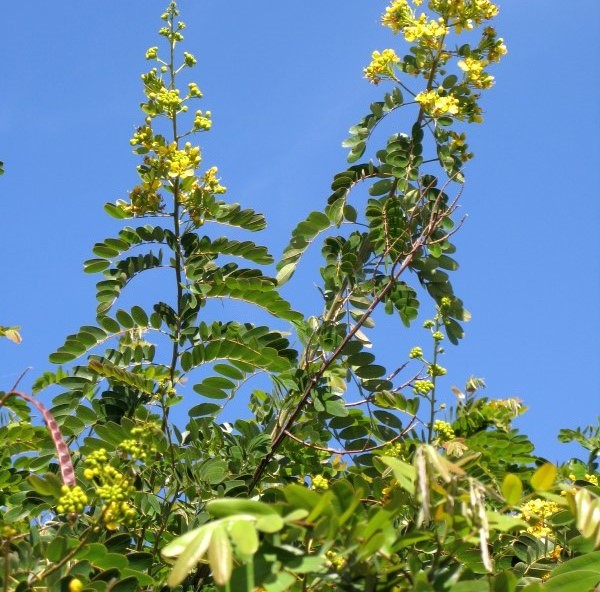|
Common Names: Winter cassia, Sticky pod, Scrambled
egg, Pintcheira do mato, Mbaraka, Mkundekunde
Local Names: Pintcheira do mato (Crioulo, Guinea-Bissau),
Gueleponsgo (Moore, Upper Volta), Shadarat al bashime / Shedrat el
(Arabic-Shuwa, Nigeria), Lomfu (Hausa, Niger), Rumbu (Kanuri, Niger), Runhu
(Hausa, Nigeria), Mfunguo (Swahili, Tanzania)
Species ID: NMP-247 | wfo-0000164785 | NCBI_Taxonomy ID: 1977557
Scientific
Classification
Kingdom: Plantae
Clade: Tracheophytes
Clade: Angiosperms
Clade: Eudicots
Clade: Rosids
Order: Fabales
Family: Fabaceae
Genus: Senna
Species: S. singueana
Synonyms: Cassia singueana Delile; Cassia goratensis Fresen.; Cassia
kethulleana De Wild.; Cassia sabak Delile; Cassia tettensis Bolle; Cassia
zanzibarensis Vatke. (Ripanda et al., 2023)
Morphological Description
- Habit & Size: Deciduous shrub or small tree, typically 4-5 m
tall, occasionally up to 11 m, with a light and open crown.
- Bark: Reddish when young, maturing to grey-brown, rough
and fissured; used medicinally for its bioactive compounds. (Burkill,
1995)
- Leaves: Pinnate compound, 4-10 pairs of oval leaflets
2.5–5.0 cm × 1–2 cm; conspicuous gland between leaflet pairs. (Fern, 2024)
- Flowers: Bright yellow, 2–3 cm in diameter, in terminal or
axillary racemes; fragrant; bloom seasonally. (Prance & Jongkind,
2015)
- Fruit: Linear pods 10–25 cm × 1–2 cm, initially green
turning brown, sticky when young; contain flattened seeds 5–7 mm. (Ripanda
et al., 2023)
- Geographic Range: Widespread across sub-Saharan Africa (Senegal to
Ethiopia, south to Namibia, Zimbabwe), Comoros, Madagascar; introduced in
parts of Asia and Australia. (Kew Science, n.d.)
- Habitat: Wooded grasslands, savanna, bushland, termite
mounds; well-drained sandy/loamy soils (pH 5.5-7.0); rainfall 500-1,500
mm; altitude up to ~2,200 m. (Fern, 2024)
- Ecological Role: Pioneer species in disturbed areas;
nitrogen-fixing roots improve soil fertility; supports pollinators.
(Burkill, 1995)
- Antimalarial: Leaf decoction used in Tanzania; ethanol leaf
extracts (200-800 mg/kg) gave ~34.5-47.3% suppression of Plasmodium
berghei in mice, and enhanced chloroquine effect. (Hiben et al., 2016)
- Antidiabetic: Stem bark acetone fraction (150-300 mg/kg)
reduced blood glucose by ~40% in type-2 diabetic rats via α-glucosidase
inhibition (IC₅₀: 3.5 µg/mL). (Ibrahim & Islam, 2014)
- Antioxidant: Methanolic bark extract: DPPH scavenging EC₅₀
~20.8 µg/mL, high phenolic content (474 mg GAE/g); reduced ROS by 47.9% in
*C. elegans*. (Sobeh et al., 2023)
- Analgesic / Anti-nociceptive: Methanol leaf extract (400 mg/kg) increased
writhing-inhibition by ~60% in mice; uses both central & peripheral mechanisms.
(Hishe et al., 2018)
- Antimicrobial: Ethyl-acetate leaf extract inhibited
*Staphylococcus aureus* and *Escherichia coli (MIC 50-100 µg/mL) in Kenya,
linked to luteolin and flavonoids. (Ochieng Nyalo et al., 2022)
- Hepatoprotective: Bark methanol extract (100-200 mg/kg) reduced ALT
& AST in d-galactosamine induced rats, comparable to silymarin. (Sobeh
et al., 2023)
⚠ Toxicity Profile: Acute oral toxicity in mice: no mortality up to
2,000 mg/kg. Sub-chronic (400 mg/kg, 28 days) showed mild ALT elevation (~10%).
High doses (>1,000 mg/kg) may cause gastrointestinal distress or
hepatotoxicity (due to anthraquinones). Use in pregnancy/children is not
established; wild-harvest risk includes heavy-metal contamination. (Ripanda et
al., 2023)
- Ornamental: Cultivated for bright yellow flowers in gardens
and parks across Africa and tropical zones. (Fern, 2024)
- Pesticidal / Larvicidal: Leaf extracts repel stored-grain insects; used as
larvicide against *Anopheles gambiae*. (Dantanko & Malann, 2020)
- Cultural: In Yoruba culture, leaves used in rituals for
fertility and purification; pods symbolise abundance. (Burkill, 1995)
- Ecological: Used in agroforestry for soil stabilisation,
especially on termite mounds; nitrogen-fixing root nodules improve soil
fertility. (Fern, 2024)
- Burkill, H. M.
(1995). The useful plants of West Tropical Africa (Vol. 3). Royal Botanic Gardens, Kew.
- Hiben, M. G., Sibhat, G.
G., Fanta, B. S., Gebrezgi, H. D., & Tesema, S. B. (2016). Evaluation of
Senna singueana leaf extract as an alternative or adjuvant therapy for
malaria. Journal of Traditional and Complementary Medicine, 6(1), 112–117.
- Hishe, H. Z., & et
al. (2018). Anti-nociceptive effect of methanol extract of leaves of Senna
singueana in mice. Journal of Ethnopharmacology, 224, 155–162.
- Ibrahim, M. A., &
Islam, M. S. (2014). Anti-diabetic effects of the acetone fraction of Senna
singueana stem bark in a type-2 diabetic rat model. Journal of
Ethnopharmacology, 153(2), 392–399.
- Ochieng Nyalo, P.,
Omwenga, G. I., & Ngugi, M. P. (2022). GC-MS analysis, antibacterial and
antioxidant potential of ethyl acetate leaf extract of Senna singueana (Delile)
grown in Kenya. Evidence-Based Complementary and Alternative Medicine, 2022, 5436476.
- Oladeji, O. S., Adelowo,
F. E., & Oluyori, A. P. (2021). The genus Senna (Fabaceae): A review on its
traditional uses, botany, phytochemistry, pharmacology and toxicology. South
African Journal of Botany, 138, 1-32.
- Ripanda, A., Luanda, A.,
Mtabazi, G. S., & Makangara, J. J. (2023). Senna singueana (Delile) Lock:
Ethnomedicinal uses and medicinal properties. Heliyon, 9(3), e14098.
- Sobeh, M., Mahmoud, M.
F., & Hasan, R. A. (2023). Senna singueana: Antioxidant, hepatoprotective,
antiapoptotic properties and phytochemical profiling of a methanol bark
extract. Molecules,
28(5), 2222.
- Fern, K. (2024). Senna
singueana. Useful Tropical Plants Database. Retrieved from https://tropical.theferns.info/viewtropical.php?id=Senna+singueana
- Kew Science. (n.d.).
Senna singueana (Delile) Lock. Plants of the World Online. Retrieved from
https://powo.science.kew.org/taxon/urn:lsid:ipni.org:names:945431-1
|
